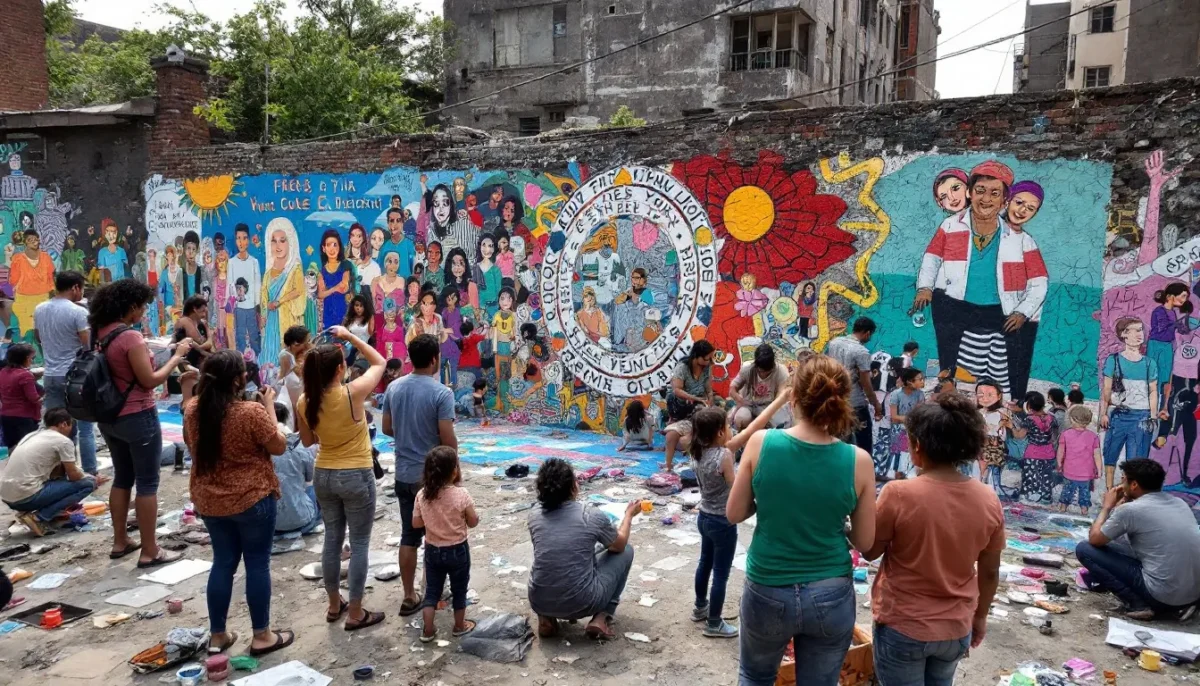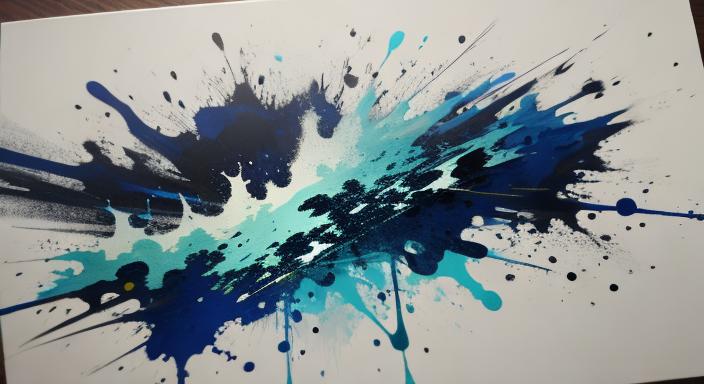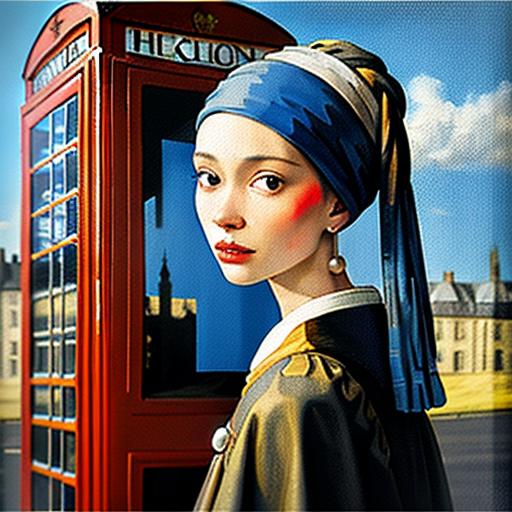Throughout history, social change and art have been deeply connected, each influencing and reflecting the other in powerful ways. From the revolutionary political statements of Mexican muralists to the digital activism of today’s street artists, creative expression has both mirrored and shaped the societies we live in. Art gives voice to the voiceless, challenges power structures, preserves cultural memory during times of transformation, and imagines new possibilities for our collective future.
Key Points:
- Art movements often emerge as responses to social and political changes
- Artists use their work to challenge systems of power and inequality
- Art provides visibility for marginalized communities and their experiences
- Creative expression can inspire action and mobilize social movements
- The relationship between art and society is reciprocal, with each influencing the other
- Today’s digital technology has created new forms of visual activism and social commentary
- The Powerful Interplay Between Social Change and Art
- The Parallel Evolution of Art Movements and Social Change
- Revolutionary Artistic Responses to Crisis
- Art as a Voice for the Marginalized
- From Canvas to Streets: The Evolution of Protest Art
- How Technology Has Transformed Artistic Activism
- Art That Heals Communities During Social Transformation
- The Economic Impact of Socially Engaged Art
- The Future of Art and Social Change
- Art's Enduring Power to Transform Society
- FAQ: Social Change and Art
- What are some famous examples of protest art throughout history?
- How do art movements reflect social inequality?
- What is the connection between propaganda and art?
- How has digital technology changed political art?
- How do museums balance artistic freedom with social responsibility?
- What role does art play in environmental activism?
The Powerful Interplay Between Social Change and Art
When societies undergo transformation, artists respond. And when artists create powerful work, they can spark change in return. This dynamic relationship has shaped human history in countless ways. Art doesn’t just hang in museums—it marches in the streets, challenges our thinking, and opens our eyes to new possibilities.
The relationship between social movements and artistic expression isn’t just about artists creating political posters or protest songs. It’s much deeper. Art provides the visual language, emotional resonance, and cultural frameworks that help us understand complex social issues. Meanwhile, social movements give artists urgent subjects, passionate audiences, and new perspectives.
Art and Social Change: A Visual History
This interactive timeline illustrates the fascinating parallel evolution of major art movements and social events throughout history. From the emotional expressions of Romanticism during the French Revolution to today’s digital activism art in our connected world, you can explore how artists have responded to—and influenced—the social and political landscape of their times.
The timeline highlights key connections: how Realism emerged alongside the Industrial Revolution, how World War I sparked the anti-establishment Dada movement, and how the Civil Rights era inspired new forms of protest art. Each period reveals how art serves not just as cultural documentation but as a powerful catalyst for social transformation.
Navigate through different time periods using the interactive filters to discover how artistic expression and social change have always been intimately connected.
The Parallel Evolution of Art Movements and Social Change
Art Movements
Revolutionary Artistic Responses to Crisis
When societies face upheaval, artists often respond with revolutionary approaches. The Dada movement emerged from the disillusionment of World War I, rejecting reason and logic in favor of nonsense and intuition. Artists like Hannah Höch and Marcel Duchamp created works that questioned everything, including the definition of art itself.
Similarly, the Great Depression sparked Social Realism, with artists documenting the struggles of ordinary people. Photographers like Dorothea Lange captured the human toll of economic collapse, while painters portrayed workers' dignity in the face of hardship.
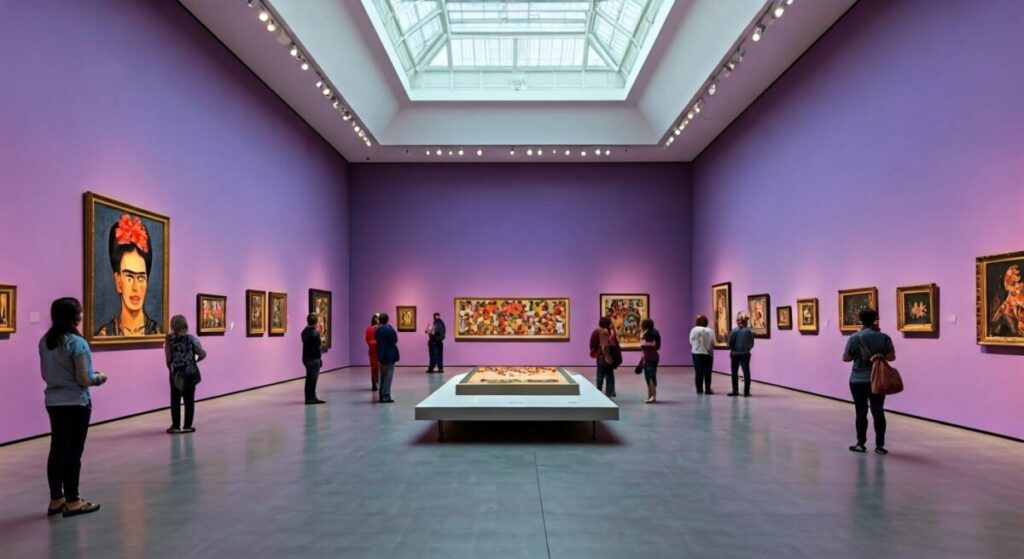
In the 1960s and 70s, as social movements for civil rights, women's liberation, and peace gained momentum, art became more explicitly political. The Black Arts Movement celebrated African American culture and identity while demanding change. Feminist artists challenged the exclusion of women from galleries and art history books.
"Art is not a mirror to reflect reality, but a hammer with which to shape it."
Bertolt Brecht
Art as a Voice for the Marginalized
Throughout history, art has given visibility and voice to people whose stories might otherwise be ignored. The Harlem Renaissance of the 1920s celebrated Black culture and creativity at a time when segregation and racism were pervasive. Writers, musicians, and visual artists created works that affirmed Black identity and achievement.
Mexican Muralism, led by artists like Diego Rivera and Frida Kahlo, celebrated indigenous culture and workers' struggles while criticizing colonialism and economic exploitation. Their large public murals brought political messages directly to the people, outside the walls of elite museums.
Today, artists from communities that have historically been marginalized continue to use their work to express identity, preserve cultural memory, and demand recognition. Indigenous artists reclaim traditional practices while addressing contemporary issues. LGBTQ+ artists document their experiences and imagine more inclusive futures.
From Canvas to Streets: The Evolution of Protest Art
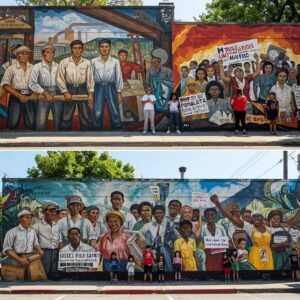
As art moved beyond elite spaces like museums and galleries, it became a more direct tool for social change. The street art movement emerged from urban graffiti culture but evolved to include sophisticated visual commentary on social issues.
Artists like Banksy use public spaces to deliver powerful political messages that reach audiences who might never visit an art gallery. Their work addresses issues from war and capitalism to migration and surveillance, often with biting humor that makes complex issues accessible.
The AIDS crisis of the 1980s and 90s spurred activist art collectives like Gran Fury and the Guerrilla Girls. These groups used the visual language of advertising to raise awareness about the epidemic and challenge institutional neglect.
During the Arab Spring, street art flourished as a form of political expression and resistance. Murals documented revolutionary moments and honored those who had died fighting for freedom.
Art as Protest Takes Many Forms:
- Murals that reclaim public space
- Performance art that disrupts "business as usual"
- Posters and banners for demonstrations
- Digital memes that spread messages virally
- Community art projects that build solidarity
- Installations that make invisible issues visible
How Technology Has Transformed Artistic Activism
The digital revolution has created entirely new possibilities for socially engaged art. Social media platforms allow artists to share their work directly with global audiences, bypassing traditional gatekeepers like galleries and museums.
Digital tools enable new forms of collaboration, with artists working across borders on shared projects. During the COVID-19 pandemic, when physical gatherings were impossible, online art initiatives kept social movements visible and connected.
AI art tools have sparked new debates about creativity and authorship while democratizing certain aspects of art creation. Apps that transform smartphone photos into stylized images have made artistic expression more accessible
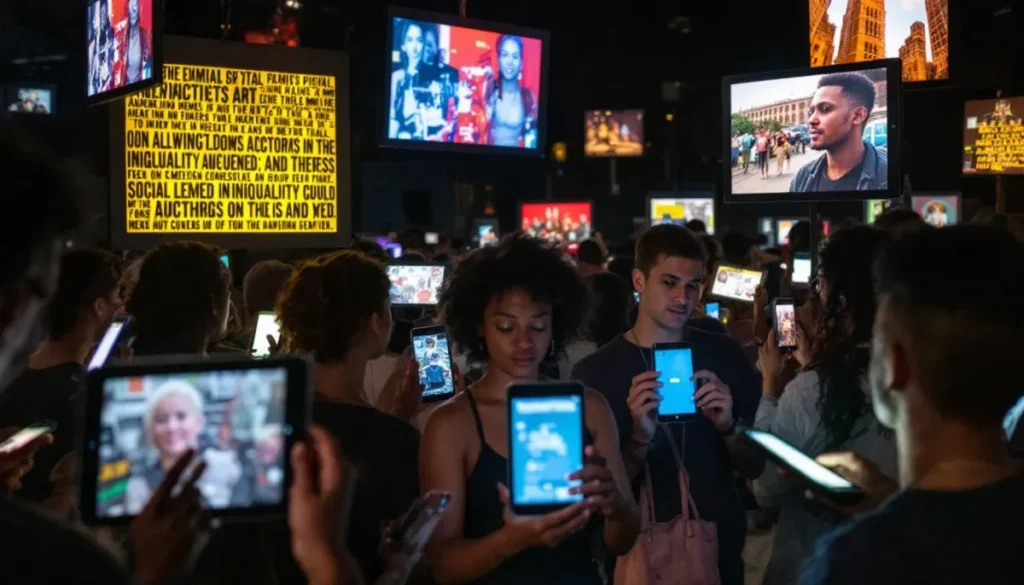
Art That Heals Communities During Social Transformation
Beyond protest and political commentary, art plays a crucial role in healing communities experiencing conflict or rapid change. Community murals bring neighbors together to create shared visions. Arts education programs give young people tools to express themselves and imagine better futures.
In post-conflict societies, art therapy helps individuals process trauma and rebuild trust. Public memorials honor victims and help communities remember difficult histories while moving forward.
During the Black Lives Matter movement, community art projects have created spaces for mourning, celebration, and imagining more just systems. Murals honoring George Floyd and other victims of police violence transform sites of tragedy into places of beauty and remembrance.
Examples of Art for Community Healing:
| Art Form | Community Impact | Examples |
|---|---|---|
| Community Murals | Build neighborhood pride and unity | Philadelphia Mural Arts Program |
| Participatory Installations | Create shared experiences | The COVID Memorial Project |
| Public Memorials | Honor victims and preserve memory | Vietnam Veterans Memorial |
| Collaborative Performances | Build empathy and understanding | Theater of the Oppressed |
| Art Therapy Programs | Help process collective trauma | Post-genocide art in Rwanda |
The Economic Impact of Socially Engaged Art
Art that addresses social issues doesn't just change hearts and minds—it can also transform economies. Creative placemaking uses arts and culture to revitalize neighborhoods while preserving their unique character and preventing displacement.
Street art has boosted local economies in cities around the world, drawing tourists and creating jobs. Social enterprise art projects provide training and employment for people facing barriers to traditional employment.
However, the relationship between art and economic development raises complex questions about gentrification and who benefits from cultural investments. Artists themselves often struggle financially, even as their work creates value for communities and property owners.
The Future of Art and Social Change
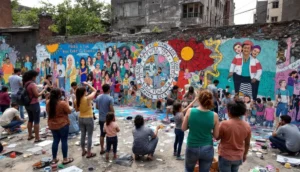
As we face unprecedented global challenges—from climate change to democratic backsliding to technological transformation—the role of art in social change continues to evolve. Virtual reality and augmented reality technologies enable immersive experiences that build empathy and understanding. Social practice artists create participatory projects that blur the lines between art, activism, and community organizing.
Young artists today are inheriting multiple crises but also unprecedented tools for creative expression and connection. Their work often addresses intersecting issues, recognizing how systems of oppression reinforce each other and how social movements must work together.
Art institutions themselves are being transformed by demands for greater diversity, equity, and accessibility. Museums are reconsidering whose stories they tell and how they engage with communities beyond their walls.
The future of social change and art will likely be more collaborative, more interdisciplinary, and more accessible than ever before. But the fundamental power of creative expression to move us emotionally, help us see differently, and imagine new possibilities remains constant.
You can watch this informative video about art and social change:
Art's Enduring Power to Transform Society
The relationship between social change and art continues to evolve with each generation, yet its fundamental importance remains constant. Whether through traditional paintings that document injustice, community murals that build solidarity, or viral digital campaigns that mobilize millions, art helps us process complex social realities and imagine different futures.
Artists have always been at the forefront of social movements—not just illustrating them, but helping to shape their vision and expand their impact. As we navigate a world of rapid technological change and urgent social challenges, the creative spirit remains essential to our collective ability to adapt, resist, and reimagine.
When we look at the profound interplay between social change and art throughout history, we see that neither exists in isolation. Each new art movement emerges from specific social conditions, and each social movement benefits from the creative energy and vision that artists provide. This dynamic relationship continues to shape our world in ways both beautiful and profound.
FAQ: Social Change and Art
What are some famous examples of protest art throughout history?
Prominent examples include Francisco Goya's "The Third of May 1808," Pablo Picasso's "Guernica," the AIDS activist art of Keith Haring, Shepard Fairey's "Hope" poster for Barack Obama's campaign, and Banksy's works addressing war, capitalism, and migration.
How do art movements reflect social inequality?
Art movements often emerge as responses to inequality, with artists documenting conditions (as in Social Realism), creating alternative visions (as in Afrofuturism), or directly criticizing systems of power. Artists from marginalized groups also create work that asserts their humanity and challenges stereotypes.
What is the connection between propaganda and art?
While propaganda and socially engaged art both aim to persuade, propaganda typically serves state interests and simplifies complex issues, while artistic expression often questions authority and embraces complexity. However, the line between them has been blurry throughout history, with governments commissioning artwork and artists sometimes creating what could be considered propaganda.
How has digital technology changed political art?
Digital technology has democratized art creation and distribution, allowing artists to reach global audiences without institutional gatekeepers. It enables new collaborative and participatory forms, rapid response to current events, and innovative techniques like projection mapping and augmented reality to deliver messages in public space.
How do museums balance artistic freedom with social responsibility?
Museums increasingly recognize their role in representing diverse perspectives and addressing social issues. Many are revisiting their collections and acquisition policies, creating more participatory programs, and acknowledging problematic histories. However, tensions remain between curatorial independence, community needs, donor wishes, and political pressures.
What role does art play in environmental activism?
Environmental art raises awareness about climate change and ecological destruction through visual impact. Artists create works using sustainable materials, document environmental damage, visualize scientific data in accessible ways, and imagine more sustainable futures. Projects like land art and eco-art directly engage with natural systems.

